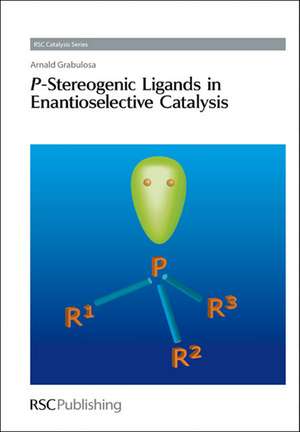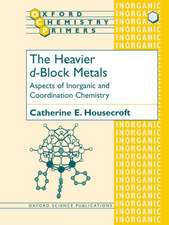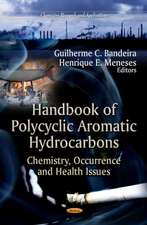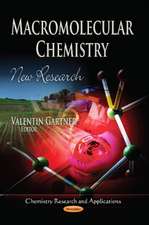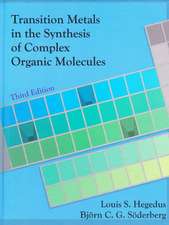P-Stereogenic Ligands in Enantioselective Catalysis: RSC Catalysis, cartea 07
Autor Arnald Grabulosaen Limba Engleză Hardback – 30 noi 2010
P-stereogenic ligands were among the first to be used in asymmetric catalysis but synthetic difficulties and prejudices have hampered their development. However, continuous screening for new chiral ligands means that they can no longer be ignored and this rigorous reference source reflects their renaissance. The book is filled with many examples from recent primary literature. The synthetic chemist will easily be able to follow the preparation methods which are accompanied by a description of the challenges and limitations. Those working in homogenous catalysis, and wanting to increase their repertoire of ligands, will be able to establish which have already been used in each reaction and their performance. This book provides comprehensive coverage of the application of P-stereogenic ligands in homogeneous catalysis. It begins with a brief chapter on generalities of P-stereogenic compounds: history, configurational stability, and interconversions among them.The book then goes on to describe the main preparative methods, from resolution of racemates to enantioselective catalysis, before focusing on the catalytic applications of P-stereogenic ligands. Chapter 7 describes the use of the ligands in catalytic hydrogenation and related reactions whereas chapter 8 deals with other reactions, mainly C-C bond forming reactions. The aim of these two final chapters is to give an outline of the usefulness of the ligands in homogeneous catalysis.
Din seria RSC Catalysis
- 14%
 Preț: 941.61 lei
Preț: 941.61 lei - 9%
 Preț: 1109.81 lei
Preț: 1109.81 lei - 14%
 Preț: 1369.88 lei
Preț: 1369.88 lei - 14%
 Preț: 1363.60 lei
Preț: 1363.60 lei - 14%
 Preț: 1120.35 lei
Preț: 1120.35 lei - 14%
 Preț: 1119.00 lei
Preț: 1119.00 lei - 14%
 Preț: 1347.55 lei
Preț: 1347.55 lei - 14%
 Preț: 1381.56 lei
Preț: 1381.56 lei - 14%
 Preț: 1248.32 lei
Preț: 1248.32 lei - 14%
 Preț: 1244.21 lei
Preț: 1244.21 lei - 14%
 Preț: 1081.57 lei
Preț: 1081.57 lei - 14%
 Preț: 1369.04 lei
Preț: 1369.04 lei - 14%
 Preț: 1378.97 lei
Preț: 1378.97 lei - 14%
 Preț: 1393.17 lei
Preț: 1393.17 lei - 14%
 Preț: 1547.47 lei
Preț: 1547.47 lei - 14%
 Preț: 775.38 lei
Preț: 775.38 lei - 14%
 Preț: 1132.10 lei
Preț: 1132.10 lei - 14%
 Preț: 946.72 lei
Preț: 946.72 lei - 14%
 Preț: 948.21 lei
Preț: 948.21 lei - 14%
 Preț: 1088.21 lei
Preț: 1088.21 lei - 14%
 Preț: 1389.84 lei
Preț: 1389.84 lei - 14%
 Preț: 951.54 lei
Preț: 951.54 lei - 14%
 Preț: 955.98 lei
Preț: 955.98 lei - 14%
 Preț: 1309.36 lei
Preț: 1309.36 lei - 9%
 Preț: 1004.63 lei
Preț: 1004.63 lei
Preț: 958.32 lei
Preț vechi: 1114.33 lei
-14% Nou
Puncte Express: 1437
Preț estimativ în valută:
183.38€ • 196.09$ • 152.89£
183.38€ • 196.09$ • 152.89£
Carte tipărită la comandă
Livrare economică 17 aprilie-01 mai
Preluare comenzi: 021 569.72.76
Specificații
ISBN-13: 9781849731232
ISBN-10: 1849731233
Pagini: 501
Dimensiuni: 158 x 239 x 33 mm
Greutate: 0.86 kg
Ediția:Edition.
Editura: Royal Society Of Chemistry
Seriile RSC Catalysis Series, RSC Catalysis
ISBN-10: 1849731233
Pagini: 501
Dimensiuni: 158 x 239 x 33 mm
Greutate: 0.86 kg
Ediția:Edition.
Editura: Royal Society Of Chemistry
Seriile RSC Catalysis Series, RSC Catalysis
Cuprins
Introduction; Resolution of Racemic and Diastereomeric Mixtures; P-Stereogenic Heterocycles; P-Stereogenic Compounds Derived from Enantiopure Heterocycles P-Stereogenic Phosphines Prepared by Enantioselective Deprotonation; Preparation by Enantioselective Catalysis; Hydrogenation and Related Reactions; Miscellaneous Reactions
Notă biografică
Arnald Grabulosa was born in Sant Joan de les Abadesses (Catalonia, Spain) in 1978. He studied Chemistry at the University of Barcelona, where he also completed his PhD on P-stereogenic phosphines in 2005, under the supervision of Prof. Guillermo Muller. Afterwards, he spent one year of postdoctoral work in Nancy (France) working with Profs Philippe Gros and Marc Beley in the application of Ru complexes to dye-sensitized solar cells. Still as a postdoctoral researcher, he moved in 2007 to St Andrews (Scotland, UK) to work with Prof. Paul Kamer in the development of DNA-based catalysts and with Dr Mattew Clarke in carbonylation reactions. In 2010, he was appointed as a Lecturer at the Inorganic Chemistry Department of the University of Barcelona.
Textul de pe ultima copertă
P-stereogenic ligands were among the first to be used in asymmetric catalysis but synthetic difficulties and prejudices have hampered their development. However, continuous screening for new chiral ligands means that they can no longer be ignored and this rigorous reference source reflects their renaissance. This book provides comprehensive coverage of the application of P-stereogenic ligands in homogeneous catalysis. It begins with a brief chapter on generalities of P-stereogenic compounds: history, configurational stability, and interconversions among them.The book then goes on to describe the main preparative methods, from resolution of racemates to enantioselective catalysis, before focusing on the catalytic applications of P-stereogenic ligands. Chapter 7 describes the use of the ligands in catalytic hydrogenation and related reactions whereas chapter 8 deals with other reactions, mainly C-C bond forming reactions. The aim of these two final chapters is to give an outline of the usefulness of the ligands in homogeneous catalysis. The book is filled with many examples from recent primary literature. The synthetic chemist will easily be able to follow the preparation methods which are accompanied by a description of the challenges and limitations. Those working in homogenous catalysis, and wanting to increase their repertoire of ligands, will be able to establish which have already been used in each reaction and their performance.
Descriere
This book provides comprehensive coverage of the application of P-stereogenic ligands in homogeneous catalysis.
